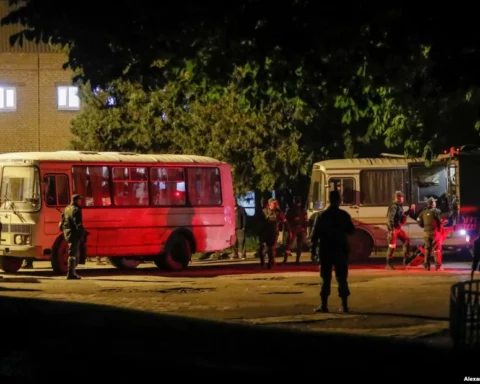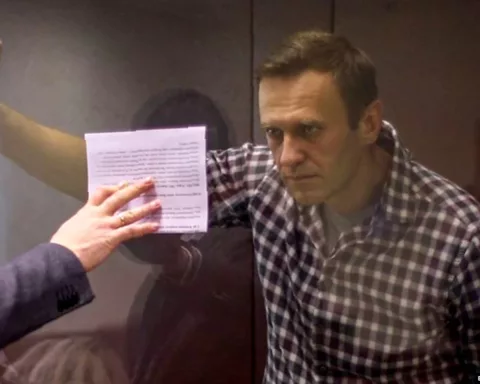Rare photographs show the construction and unveiling of some of the famous monuments built during Yugoslavia’s socialist era.
The unearthly memorials known as “Spomeniks” (the Serbo-Croatian word for “monument”) dotted throughout the former Yugoslavia are some of the most distinctive remnants of the Balkans’ authoritarian past. The public artworks shot to fame around a decade ago when a Belgian photographer captured dozens of them as eerie remnants of a vanished nation.
In the Archives of Yugoslavia, hundreds of photographs capture the Spomeniks when they were bustling with life, either as they were being built, while being opened, or during memorial events. The photos below were made available to RFE/RL thanks to the staff at the Belgrade archives.

The construction of the Kadinjaca memorial complex on a hilltop near Uzice, in today’s Serbia, in 1979.
The memorial marks the ridge where partisans and armed workers fought advancing Nazi troops in November 1941. The battle ended in the deaths of nearly all of the 400 workers, but gave the civilians in Uzice time to flee the German advance.

Scaffolding surrounds the iconic “bullet hole” of the Kadinjaca monument, which can be seen from dozens of kilometers away.

A view to the modest centerpiece of the 1979 monument. The steeple-shaped memorial was already in place when the decision to expand the memorial site around it was made by the Yugoslav authorities.

A crowd gathers at the completed Kadinjaca monument spomenik shortly after its unveiling in 1979.

Workers hammer at the walkway leading through the nearly completed Monument to the Bosanska Krajina Partisan Hospital in today’s Bosnia-Herzegovina in 1979.

The clam-shaped memorial was built to honor a secret hospital that treated wounded fighters and other members of the anti-Nazi underground on the flanks of Grmec Mountain. The spomenik now lies abandoned and largely ruined.

Workers put the finishing touches on a monument atop the Makljen Pass commemorating a major 1943 battle between Yugoslav partisan and fascist forces. The photo was probably taken in 1978, the year it was completed.
The monument was known colloquially as “The Fist” but its designer later said it was intended to resemble a flower “laid along the path” of the heroes who fought the fascist advance.

The Makljen Spomenik shortly after completion. The monument ended up on the front lines during much of the ethnically-charged fighting that tore through the Balkans in the 1990s. In the winter of 2000 an unidentified group destroyed the spomenik. Today, all that remains is a tangle of concrete and rebar.
Researchers believe the striking, abstract designs of the Yugoslavian monuments served two purposes. Firstly, they helped to create a sharply different aesthetic to the socialist-realist art mandated in the Soviet Union. Yugoslavia’s authoritarian ruler, Josep Tito, fell out with Josef Stalin and their two countries remained at odds for years. Tito famously warned Stalin he would have him killed if the Georgian didn’t stop sending assassins to Belgrade.
The abstract designs of spomeniks also attempted to deal with the political land mines that many of the historic sites represented. Some of the monuments mark sites where horrifying slaughters were carried out by one Balkan ethnic group against another. Any clear representation of those crimes could have stoked tensions in a multiethnic police state where “brotherhood and unity” was rigidly enforced by the authorities.

Crowds gather on a rainy day in 1980 to mark the anniversary of the liberation of the Jasenovac death camp in which tens of thousands of Serbs, Roma, and Jews were slaughtered by Nazi-aligned Croats during World War II. The concrete “flower” built to commemorate the dead was completed in 1966.

The opening ceremony of the Jajinci Memorial Park in Belgrade in October 1989. The park was the scene of mass killings by Nazi forces who occupied the city through much of World War II.

Workers during construction of the Vraca Memorial Park, on a hill above Sarajevo in 1981. The workers are emplacing the names of the local victims of fascist repressions onto the stone of an old fortress. Today the site is largely ruined and the name plates have been lost or stolen.

A collection of field guns from World War II lies inside the massive, saucer-shaped memorial to the Sremski Front, a final battle that helped push Nazi-led forces out of the Balkans.

Young men put the finishing touches on the Sremski Front memorial in 1988. The memorial complex lies near the border of today’s Serbia and Croatia.

Politicians walk along the exterior of the memorial to the Sremski Front shortly after the site’s unveiling in 1988.
Amos Chapple
Amos Chapple is a New Zealand-born photographer and picture researcher with a particular interest in the former U.S.S.R.





